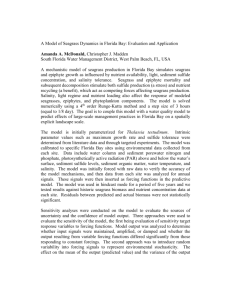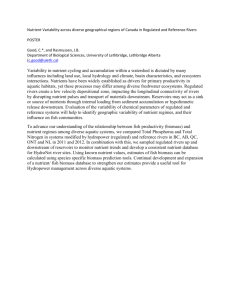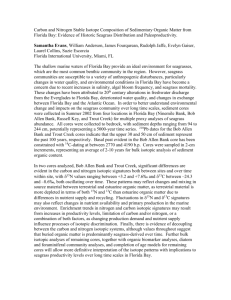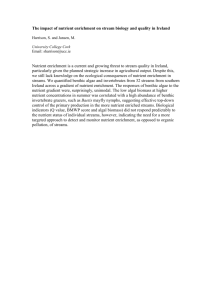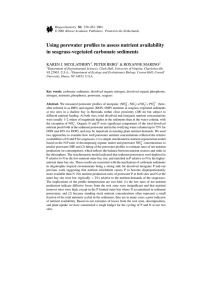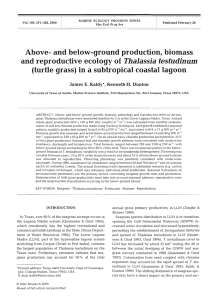Use of a dynamic, mechanistic simulation model to assess ecology
advertisement
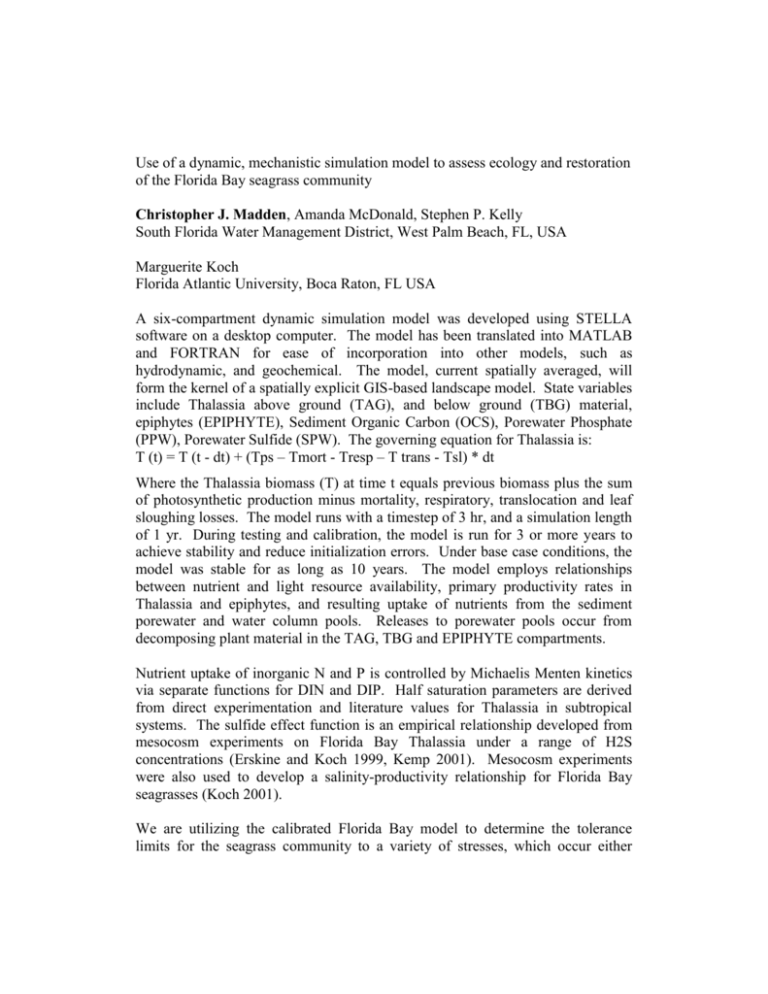
Use of a dynamic, mechanistic simulation model to assess ecology and restoration of the Florida Bay seagrass community Christopher J. Madden, Amanda McDonald, Stephen P. Kelly South Florida Water Management District, West Palm Beach, FL, USA Marguerite Koch Florida Atlantic University, Boca Raton, FL USA A six-compartment dynamic simulation model was developed using STELLA software on a desktop computer. The model has been translated into MATLAB and FORTRAN for ease of incorporation into other models, such as hydrodynamic, and geochemical. The model, current spatially averaged, will form the kernel of a spatially explicit GIS-based landscape model. State variables include Thalassia above ground (TAG), and below ground (TBG) material, epiphytes (EPIPHYTE), Sediment Organic Carbon (OCS), Porewater Phosphate (PPW), Porewater Sulfide (SPW). The governing equation for Thalassia is: T (t) = T (t - dt) + (Tps – Tmort - Tresp – T trans - Tsl) * dt Where the Thalassia biomass (T) at time t equals previous biomass plus the sum of photosynthetic production minus mortality, respiratory, translocation and leaf sloughing losses. The model runs with a timestep of 3 hr, and a simulation length of 1 yr. During testing and calibration, the model is run for 3 or more years to achieve stability and reduce initialization errors. Under base case conditions, the model was stable for as long as 10 years. The model employs relationships between nutrient and light resource availability, primary productivity rates in Thalassia and epiphytes, and resulting uptake of nutrients from the sediment porewater and water column pools. Releases to porewater pools occur from decomposing plant material in the TAG, TBG and EPIPHYTE compartments. Nutrient uptake of inorganic N and P is controlled by Michaelis Menten kinetics via separate functions for DIN and DIP. Half saturation parameters are derived from direct experimentation and literature values for Thalassia in subtropical systems. The sulfide effect function is an empirical relationship developed from mesocosm experiments on Florida Bay Thalassia under a range of H2S concentrations (Erskine and Koch 1999, Kemp 2001). Mesocosm experiments were also used to develop a salinity-productivity relationship for Florida Bay seagrasses (Koch 2001). We are utilizing the calibrated Florida Bay model to determine the tolerance limits for the seagrass community to a variety of stresses, which occur either naturally or as a consequence of human activities. Data from mesocosm experiments on the effects of high salinity will be applied to the model to project how water management effects on the salinity regime will impact the plant community. The model is also being used to predict the mix of environmental factors required to sustain or restore the seagrass community via management of specific variables in the environment, particularly freshwater input, nutrient input and water transparency. An index indicating the status of nutrient and light limitation in the model was developed so that at any point in time the instantaneous level of nutrient or light stress is known. This is useful in determining the effects of seasonal or transitional stresses on the plants as well as the effects of synergistic phenomena that may be incurred in combination with salinity or temperature stresses. In general, if light is sufficient, the plant will show signs of physiological stress when nutrients are limiting. We are correlating field measurements of stress via fluorescence (PAM) with the nutrient and light environments of the plants for incorporation into the model. Measurements were taken in the field to determine the level of stress of plants at five sites across a gradient of nutrient availability from Duck Key to Rankin Lake. Because Florida Bay waters are shallow and clear, it is generally accepted that it is nutrients that are limiting to plants in large parts of the Bay. Indeed, experiments have shown that additions of nutrients result in increased plant growth. However, the abundant growth of Thalassia in many parts of the Bay, such as Rabbit Key and Twin Key Basin, beg the question: what are the sources that provide nutrients in sufficient quantity to permit luxuriant plant growth beyond that expected based on available nutrient concentrations? Our model allows probing of this question by testing several hypotheses related to nutrient supply and availability. First, we are running the model using measured parameters of growth and tissue stoichiometry in the model to develop projections of nutrient demand. Then, we are constraining nutrient supply in the model from sources that are well documented- water column and sediment pools. The free terms such as recycling rate and abiotic processes are then being optimized to develop predictions of probable levels and supply rates. These results will then be followed up with targeted verification experiments. In areas where seagrass growth is luxuriant, such as in Rabbit Key, and Barnes Sound, there are indications that light limitation by self-shading, even in very clear waters, may affect plant production. We are using the model to test this hypothesis and to quantify the light levels that may be deleterious to plant production. By manipulating the terms of the model to reflect expected changes in nutrient and light resources due to both natural and managed effects, we hope to predict the trajectory of the seagrass community in terms of biomass, distribution and species composition, as restoration continues. We are also directing model development toward addressing effects of the interaction between seagrass plant morphology, bed configuration and ecological rate processes. The physical structure of the bed and of individual short shoots does affect the use of the resource environment. Light penetration through the canopy and self shading are determined by length, density and number of leaves on the short shoots; above to below ground biomass ratio determines the allocation of fixed carbon, and rates of lateral versus vertical propagation. We have developed the following general rules set to selectively apply to the seagrass community in our model to test various hypotheses about how plant behavior and form affect ecological processes: In turbid environments, plants grow taller, and more widely spaced In highly sedimentary or resuspended environments, more biomass is invested in vertical rhizomes and in below ground material In nutrient poor environments, leaves are thinner In areas adjacent to bare areas, lateral growth is more rapid, decreasing with increasing adjacent biomass In areas with higher P, tissue concentrations of P are elevated and the uptake of P is greater. The model was adapted to incorporate a subset of these rules as a heuristic exercise to determine the sensitivity of target variables biomass and production to environmental conditions that invoke these rules. This model has proved to be an effective organizing framework for information about seagrasses in Florida Bay, demonstrating gaps in data and pointing to research needs. It is also a valuable tool for hypothesis testing and a predictive tool for testing management options. Christopher J. Madden, Florida Bay and Lower West Coast Division, South Florida Water Management District, 3301 Gun Club Rd., West Palm Beach, FL, 33406. Phone:(561)753-2400 x4647 Fax:(561)791-4077, cmadden@sfwmd.gov, Question 4.
